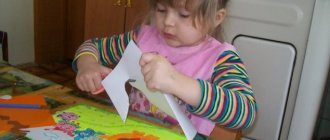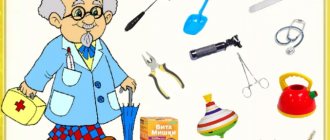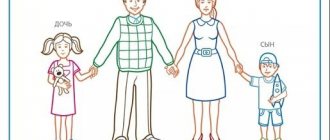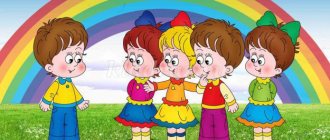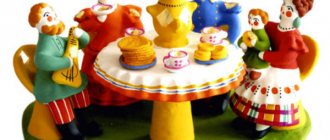Gouache creations
Step-by-step instructions for children:
- Draw a blue horizontal ruler just below the middle of the sheet.
- On top of it there is a sky of the same shade, darkening towards the top, with white clouds.
- Below the main feature a pale blue river flows.
- Closer to the edge, the earth is drawn in yellowish and brown colors.
- Dark brown trees are reflected in the water surface with ripples.
Foliage in red, burgundy, and orange tones is scattered on them, emphasizing the naturalistic autumn color, but the spruce will act as a greenish accent.
The simplest options
Young artists are able to depict the sad natural season.
Master class for beginners step by step with a pencil:
- The paper canvas is divided by the horizon line.
- The foreground will be occupied by trees whose dark, as if saturated with moisture, trunks have different thicknesses and are located with a slight slope. Their bases are slightly wavy.
- Next, a river with an uneven bank is identified.
- Tree branches, bushes, grass and fallen leaves are drawn in the coastal area.
- Shade the trunk shadow.
- The background has a blurred appearance associated with dampness and cloudiness.
- The sky is filled with heavy clouds.
- A flock of birds flying away for the winter will add to the realism.
The pencil technique conveys light and shade and the three-dimensionality of objects, and errors are corrected with an eraser. Instead of a river, a road in a park alley may be shown, narrowing into the distance, a lonely figure wandering along it, lanterns on the side of the road.
- Having sketched the sketch, trace the contours with a felt-tip pen.
- The crowns are yellow, shaded on one side with a light brown pencil.
- The green spot represents the ground and fir trees.
- Give color to the human silhouette.
When thinking about how to draw autumn with a pencil, they turn to their own subjects or copy from the base.
An interesting idea - an umbrella forgotten on a bench.
- The legs of the bench are drawn at an angle.
- On the open dome there are knitting needles and a handle.
- Puddles and leaves on the asphalt are drawn with strokes.
- You can add oblique lines of a rainfall.
It turns out to be a very nostalgic picture.
Extraordinary picture
A suggestion on how to beautifully draw a landscape of a non-standard nature.
- In the upper left corner, a circle is applied with white paint, then, adding blue, we continue to make circular movements with the brush, expanding the coverage area, switching to a blue gradient.
- Having marked the horizon, we paint the bottom dark blue, and in the center we draw a dark green island with blurred edges.
- Using a thin black brush we depict a tree with branched branches and roots.
- We decorate the leafy cap with a sponge in a reddish color scheme, with an elongated trajectory covering the moon.
- On top of the intricate crown there are additional strokes of yellow color, resulting in snow-white.
- We highlight the lunar disk in relief, chaotically draw falling leaves, and spray stars at the top.
Preview:
Municipal autonomous preschool educational institution
city of Naberezhnye Chelny “Combined kindergarten No. 23 “Firefly”
Summary of a drawing lesson in the preparatory group
Naberezhnye Chelny, 2021.
Arouse children's interest in late autumn, mosses growing on trees, stones, and forests, and develop the ability to be emotionally distracted by the mood of sadness conveyed in poetry. Arouse the desire to express this state with the help of color in a landscape drawing.
- practice naming autumn signs to enrich children’s vocabulary;
- form ideas about neutral colors (black, white, dark gray, light gray, brown), use these colors when creating paintings of late autumn;
- develop the ability to independently convey in a drawing the landscape of late autumn, its color (the absence of bright colors in nature);
- practice the ability to draw trees of different structures and bushes without leaves, draw growing moss on trees, stones and ground;
- consolidate drawing techniques with the end of the brush;
-continue to develop the ability to feel, understand and reproduce the imagery of the language of a poem;
- develop coordination of movements, accompanying speech;
— develop fine motor skills through finger play;
- cultivate a love for poetry and native nature;
- cultivate an aesthetic perception of nature;
— to cultivate in children an interest in drawings, a desire to look at and talk about them.
Sample made by the teacher. Landscape sheets of paper, watercolors, palette, brushes.
Reading poems by Russian poets about autumn by A. N. Pleshcheev, A. S. Pushkin, and others.
Memorizing poems about autumn “Autumn” by M. Khodyakov and “The Swallows Are Missing” by A. Fet. Poems about mosses.
A conversation about late autumn and its signs.
Examination of reproductions of paintings by famous artists in the presentation “Late Autumn through the Eyes of Artists.” Presentations about mosses.
Examination of illustrations, pictures, reproductions.
Observations (of the sky; trees; growing mosses: on trees, foundations, ground; rain; snow) while walking.
— Guys, what time of year is it now?
— What autumn months do you know? What month is it? November is the last month of autumn.
- Listen to A. Pleshcheev’s poem, what autumn is the poet talking about?
Withers and turns yellow
Grass in the meadows
A cloud covers the sky
The sun doesn't shine
The wind howls in the field,
—Are you happy about this picture painted by the poet?
— What signs of late autumn does Pleshcheev talk about in the poem?
- Indeed, the poem talks about a dull, gloomy, cold autumn. The leaves have fallen off the trees, the grasses wither and turn yellow, the bushes are dull and bare, the flowers have dried up, the birds have flown to warmer climes, and it often drizzles.
— Autumn is like the evening of the year. And in the evening we get ready for bed. So the trees took off their clothes and washed themselves with the rain. Wildlife falls asleep. Late, gloomy autumn has arrived. In late autumn there are often cold drizzling rains, sometimes snow or sleet, the trees shed their last leaves, the grass has dried up, the flowers have withered. The last birds fly south. Animals are preparing for winter, people put on warm clothes, moss continues to grow as it grows on trees, foundations, and the ground.
— The rain is knocking on our windows and inviting us to play.
A drop once a drop two. (Children perform jumps on two legs)
Very slowly at first, (Holding hands, children walk in a circle)
And then, then, then
Everybody run, run, run. (Walking in a circle with acceleration)
We opened our umbrellas, (We make a dome over our heads with our hands)
Sheltered herself from the rain. (Squat down)
- Today I invite you to draw late autumn. What colors will you need for this - warm, bright or cold, gray?
— Look at the picture depicting late autumn. What color is the sky? - What trees?
— What signs of autumn are depicted? (light snow, gloomy sky, there are no leaves on the trees, but moss grows on the trunk and branches on stones and ground).
— Now I’ll tell you how to get these dim colors. You have palettes on your tables; artists use these palettes to compose paints. And you, like real artists, will do this.
— What paint do we need to mix to get gray paint? (add a drop of black to white paint).
— Yes, to get gray paint you need to add a little black paint to the white one. If you are painting clouds, then take blue paint and add a little black and white paint to it, mix them on the palette. The color of leaves and grass in late autumn also lost its brightness - it is brown. Take green paint and add a little yellow and brown to it - you get a brown color.
- So, first you need to make up the desired paint on the palette, and then draw with it on the sheet.
Watercolor
A sketch that includes several trees and a small village house will help you draw autumn step by step.
Execution order:
- On the central hill we place the main object - a large tree. Elevation will allow you to present the foreground and background in a new way.
- Fill the sky with an uneven background.
- In the same way, distant plantings characterized by blurriness are designed.
- Now the grass and bushes in the background stand out. Tall specimens are darker than grass.
- The house is accentuated by the light color of the nearby tree, which attracts attention. We add windows and a roof to it.
- We add volume to the central elements by playing with chiaroscuro.
- We draw a winding path and add some crimson to the bushes.
- Using strokes we highlight the color tints of the crowns.
- Using warm shades we accentuate the background; it has pronounced detail.
The picture needs to be dried and individual details drawn with colored pencils. The final step is checkmark birds flying to warm countries.
Ideas for kids
Sketches can look like mushrooms in a basket, or a vegetable still life. Toddlers will especially enjoy working with prints. Their small palm, printed on paper, will appear as a tree on which they will place numerous colored leaf dots with cotton swabs. They also operate with an ordinary toothbrush.
- The leaf blades of acacia, ash, birch, and maple have a diverse configuration and color. They are outlined and painted, repeating the characteristic veins and patterns.
- After covering with paint, the samples are applied to the painted pot, obtaining a believable bouquet, to which it is easy to attach an image of fruits - acorns, chestnuts, rose hips, a bunch of rowan berries “blazing” with fire.
The overlay method is the answer to the question of how to draw autumn easily and quickly. This way you can depict a real multi-colored forest by painting on the tree trunks and sprinkling an orange scattering of droplets from below.
In the same way, they recreate a whole armful of leaves on the territory of the park, over which birds fly in a flock, and if the adults reproduce a girl’s face, the children will happily imitate the hair of an autumn girl with leaf prints.
In addition to the aesthetic pleasure of creativity, children learn to understand types of vegetation, which will undoubtedly benefit them.
